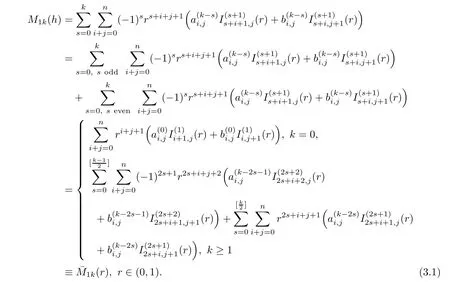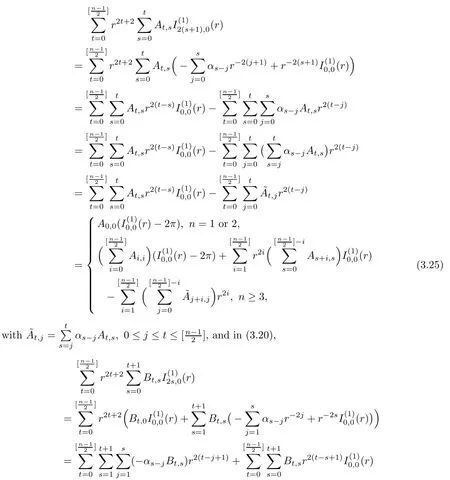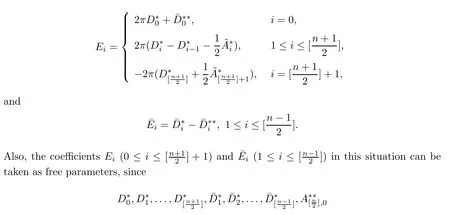LIMIT CYCLE BIFURCATIONS OF A PLANAR NEAR-INTEGRABLE SYSTEM WITH TWO SMALL PARAMETERS∗
2021-09-06梁峰
(梁峰)
The Institute of Mathematics,Anhui Normal University,Wuhu 241000,China E-mail:liangfeng741018@126.com
Maoan HAN (韩茂安)†
Department of Mathematics,Zhejiang Normal University,Jinhua 321004,China Department of Mathematics,Shanghai Normal University,Shanghai 200234,China E-mail:mahan@shnu.edu.cn
Chaoyuan JIANG (江潮源)
The Institute of Mathematics,Anhui Normal University,Wuhu 241000,China E-mail:jcy7368591@126.com
Abstract In this paper we consider a class of polynomial planar system with two small parameters,ε and λ,satisfying 0< ε ≪ λ ≪ 1.The corresponding first order Melnikov function M1with respect to ε depends on λ so that it has an expansion of the form M1(h,λ)=.Assume that M1k′(h)is the first non-zero coefficient in the expansion.Then by estimating the number of zeros of M1k′(h),we give a lower bound of the maximal number of limit cycles emerging from the period annulus of the unperturbed system for 0<ε≪λ≪1,when k′=0 or 1.In addition,for each k∈ N,an upper bound of the maximal number of zeros of M1k(h),taking into account their multiplicities,is presented.
Key words Limit cycle;Melnikov function;integrable system
1 Introduction and Main Results
Consider the planar near-integrable system

ε>
0 is small,p
(x,y
)andq
(x,y
)are arbitrarypolynomials with degreen
and independent ofε,F
(x,y
)is a particular polynomial withF
(0,
0)/=0,
and the dot denotes a derivative with respect to the variablet
.The unperturbed system of(1.1)has a period annulus around the origin.

Motivated by the works mentioned above,especially the method used in[14],in this paper we extend the bifurcation method with two small parameters of near-Hamiltonian systems[8]to consider limit cycle bifurcations of the near-integrable system

<ε
≪λ
≪1 and

ε
=0,system(1.2)has a center at the origin and two parallel lines of singular points
<
−x
<x
forλ>
0 small.Then,on the region|x
|<
|x
|,
system(1.2)is equivalent to the near-Hamiltonian system
whose unperturbed system has a family of periodic orbits given by

λ
=0,L
(h,λ
)reduces to
ε
:


Where,by Lemma 2.1 in the next section,






Theorem 1.1
Consider system(1.
2)withn
∈Zand 0<ε
≪λ
≪1.
Then,fork
∈N,


2 Preliminary Lemmas
In this section we provide some preliminary lemmas in order to prove Theorem 1.1.
Lemma 2.1
Fork
∈N,the integral formula ofM
(h
)in(1.
8)holds.Proof
Letx
∈(−1,
1).
Then,the perturbed terms of system(1.
4)have the following expansions for 0<λ
≪1:
Inserting(2.1)and(2.2)into(1.6)yields



On the other hand,by(1.5),the first equality in(2.4)and the derivative formula in Lemma 2.1[8],we have


M
(h,λ
)is independent ofλ.
Hence,(1.7),(2.3)and(2.4)together give
Lemma 2.2
Denote
Proof
The proofs of statements(i)and(ii)are straightforward.(iii)From(2.5),we have,fori
∈N andm
∈Z,
Thus,the statement(iii)holds.
(iv)Making a changet
=θ
−π
,we get,from(2.5),that forr
∈(0,
1),
Then,by the integral formula

the first formula of(iv)is valid.
For the second formula of(iv),


which,together with the integral formula

and the first formula of(iv),yields

In view of(iii)and the first two formulae of(iv),it is clear that the third one of(iv)holds.
(v)Since,by(2.5),

Lemma 2.3
Form
∈Z,
r
of degree−m
,andϕ
(r
)denotes a polynomial inr
with degreem
−1 andϕ
(r
)=2π,ϕ
(r
)=π
(2−r
).
Proof
We only give the proof of the casem>
0 by mathematical induction.The proof for other two cases is clear.First,whenm
=1,
2,the equality(2.
6)holds,by the first two formulas of(iv)in Lemma 2.2,whereϕ
(r
)=2π,ϕ
(r
)=π
(2−r
).
Suppose that(2.
6)works form
=3,
4,...,i.
Then,form
=i
+1,we have,by the statement(v)of Lemma 2.2,that
r
of degreei.
Therefore,(2.
6)is obtained for allm
≥1.

Lemma 2.5
Fork
=1 or 3,m,n
∈Zandr
∈(0,
1),
the followingm
+n
+1 functions are linearly independent:
k
=1 or 3,the functions in the above are linearly independent in the interval(0,1).Thus,the conclusion of the lemma follows.3 Proof of Theorem 1.1
3.1 Proof of Theorem 1.1(i)


n
≥1 andr
∈(0,
1),
k
≥1,
k
≥1,




Then,by using very similar methods as to those in(3.7)–(3.8),we further have,by(3.11)and Lemma 2.3,that


By Lemmas 2.2 and 2.3,we note that in(3.15),


3.2 Proof of Theorem 1.1(ii)


s
≥1 andr
∈(0,
1),
s
≥1,
Using(3.23),we have in(3.20)that







n
≥2,




H
(1)≥2.
Forn
=2,we have,similarly,that
H
(2)≥2.
Whenn
≥3 is odd,substituting(3.33)and(3.41)into(3.30)shows that
n
≥3 odd,we get
n
≥3,

can be chosen arbitrarily,then so can the coefficients




can be chosen arbitrarily and


k
=1,
we conclude that the statement of Theorem 1.1(ii)holds in this case.杂志排行
Acta Mathematica Scientia(English Series)的其它文章
- CONSTRUCTION OF IMPROVED BRANCHING LATIN HYPERCUBE DESIGNS∗
- SLOW MANIFOLD AND PARAMETER ESTIMATION FOR A NONLOCAL FAST-SLOW DYNAMICAL SYSTEM WITH BROWNIAN MOTION∗
- DYNAMICS FOR AN SIR EPIDEMIC MODEL WITH NONLOCAL DIFFUSION AND FREE BOUNDARIES∗
- A STABILITY PROBLEM FOR THE 3D MAGNETOHYDRODYNAMIC EQUATIONS NEAR EQUILIBRIUM∗
- THE GROWTH AND BOREL POINTS OF RANDOM ALGEBROID FUNCTIONS IN THE UNIT DISC∗
- SHOCK DIFFRACTION PROBLEM BY CONVEX CORNERED WEDGES FOR ISOTHERMAL GAS∗
